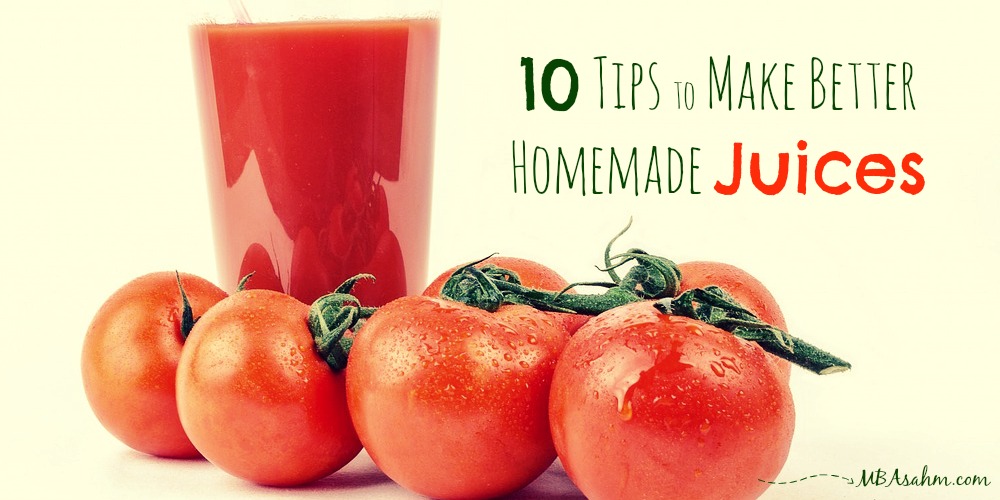I’m a huge fan of making homemade juices, so I’m obviously doing everything possible to make them better and better. I’ve done tons of experimenting (some worthwhile, some not so much) and I’ve come across some interesting things. First and foremost, juicing has been an awesome addition to our diet. So much so that even my toddler gets excited when we pull out the juicer.
If you’ve already made the plunge into homemade juices, then hopefully these tips will be helpful. And if you haven’t, then I highly recommend you try it out and then come back to put these tips to good use. 🙂
Here we go:
Color Matters
Technically, the color shouldn’t really matter. You’re getting nutrients no matter what and the taste is what really matters….except for the fact that we eat with our eyes first EVEN if we know it shouldn’t matter. So try to make your drink pretty and your eyes and stomach will both be pleased. The upside of caring about color is that it’s a great reason to test out new veggies. There are also quite a few veggies that come in a variety of colors – sweet potatoes, carrots, bell peppers, and apples are just a few. So you can use those a lot and still have a juice that looks different.
Add Chia the Night Before
My husband and I started doing this and are soooo happy with the results. Chia is great in drinks and it’s a huge source of fiber and Omega 3’s so you’ll be adding a ton of nutritional value to your juices. Chia will absorb an insane amount of liquid, so you want to give it a few hours before you drink it (that’s why I make it the night before). Making the juice the night before is also nice because your juice will be really, really cold for you in the morning.
Go Heavy on the Veggies
Even though there are lots of nutrients in fruit, nothing can compare to vegetables – especially the green leafy kind. And the reality is that it is usually much easier to slip fruits into your diet than vegetables, so use your juicing as an opportunity to really fill up on nutritious veggies. At first this can be hard, but I promise there are easy ways to do this. Which brings me to my next two tips…
Use Sweet Veggies
Believe it or not, there are a lot of vegetables that are really, really sweet when you juice them. The biggest winners in my book are carrots and sweet potatoes. Bell peppers are also a great sweetener, but they are technically a fruit! Despite that designation, I still count them as veggies, so try adding them in your next juice to mix up your flavors.
Use Tasteless Veggies
You know what a handful of spinach tastes like when you juice it? Nothing. Seriously, it tastes like nothing. So you know what that means – a handful of spinach should be in every single juice that you make. I also am a fan of eggplant in juices, which is also really, really mild. An eggplant also yields a lot of juice, so it’s a great filler.
Use Sweet Potatoes for Creaminess
Sweet potatoes are one of nature’s natural creamers. A good sweet potato can turn any juice into a creamsicle. It will also make your juice more filling and they are unbelievably healthy (way healthier than white potatoes, so don’t confuse the two).
Vary Your Fruits and Veggies
This sounds like a no-brainer, but it is harder than you think. When you don’t really know what you’re doing, there’s a tendency to just throw lots of fruits and veggies into the juicer and see what comes out. It’s also easy to rely on your favorites that you know are good. But varying your fruits and veggies will not only introduce you to new tastes and nutrients, but it will also make the juicing habit long-lasting and sustainable. Your favorites will be more exciting because they won’t happen everyday.
Shop in the Seasonal Section
Using seasonal fruits and veggies has 3 major benefits – 1. It’s a great way to vary what you’re eating (which has it’s own benefits listed above), 2. You are more likely to have access to organic varieties, and 3. It will be way cheaper. Not to mention that seasonal fruits and veggies always taste better (and you’re most likely helping out your local farmers).
Pay For the Dirty Dozen to Be Organic (And Save on the Rest)
Every year the Environmental Working Group tests produce and publishes a list of the “Dirty Dozen” fruits and vegetables – those with the highest content of chemical residue. This year, the unlucky winners of that test are: apples, peaches, nectarines, strawberries, grapes, celery, spinach, sweet bell peppers, cucumbers, cherry tomatoes, imported snap peas, and potatoes. The opinions on the benefits and/or drawbacks of organic foods vs. non-organic foods differ depending on who you ask, but if you want to make an effort to avoid potentially harmful chemicals these are the fruits and veggies to pay the extra buck to get organic. Then you can save your money on the rest by purchasing the non-organic version.
Prepare Your Vegetables (But Not Juice) Ahead of Time
Unfortunately homemade juices will lose their nutritional value about 24-48 hours after being juiced. So while it may be easier to produce all of your juices days ahead of time, you may actually be losing important nutrients. Instead, you should prepare the fruits and vegetables themselves – wash, peel, slice, etc. so that all you need to do is throw them in the juicer when you’re ready. If you can store them in the fridge you’ll be even happier because then your juices will be fresh AND cold.
BONUS – Add a Little Vodka
Ok, I gave you 10 healthy, thrifty, and delicious tips, so here’s a little bonus tip if it floats your boat – add a little vodka! Please, don’t do this with your morning juice. But if you’ve had a hectic day and are looking for a way to still squeeze in some nutrients and take the edge off, then this is it. Throw back your heels and enjoy!
I hope these tips were helpful. Cheers!
Follow Nikki @ MBAsahm’s board Smoothies and Juices on Pinterest.
1 Comment on 10 Tips to Make Better Homemade Juices
Comments are closed.



Great tips. Thanks for sharing on the Healthy Living Link Party